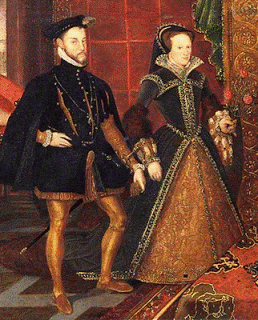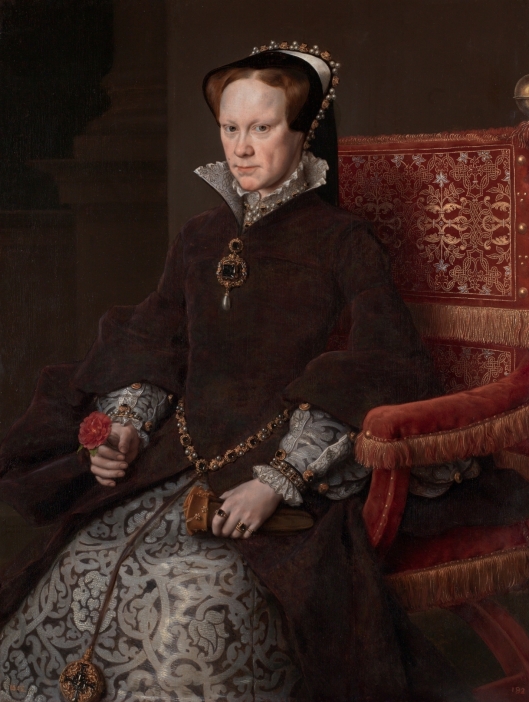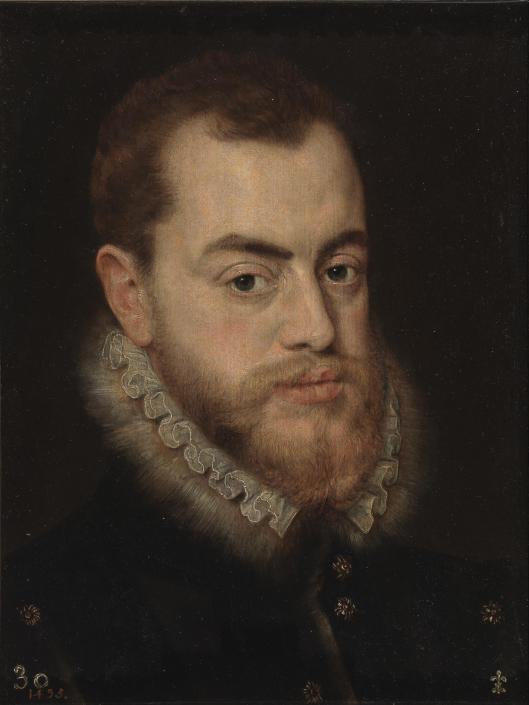Mary Tudor was England’s first queen regnant. As mentioned in the initial post announcing the series, Mary I of England is acknowledged as the first Queen to reign in her own right despite the brief, disputed reigns of the Empress Matilda and Lady Jane Grey.
In 1554, Mary married the future King Felipe II of Spain, becoming queen consort of Habsburg Spain on his accession in 1556. He was the eldest son of Holy Roman Emperor Charles V, who is also Carlos I of Spain, and Eleanore of Portugal.

Felipe’s father arranged this marriage to 37-year-old Queen Mary I of England, Charles’ maternal first cousin. Charles V ceded the crown of Naples, as well as his claim to the Kingdom of Jerusalem, to Felipe in order to give his son equal status to his wife upon their marriage.
Their marriage at Winchester Cathedral on July 24, 1554 took place just two days after their first meeting. Lord Chancellor Gardiner and the House of Commons petitioned Mary to consider marrying an Englishman, preferring Edward Courtenay.
On the part of Felipe, the marriage was purely political. Felipe had no amorous feelings toward Mary and sought the marriage for its political and strategic gains; Felipe’s aide Ruy Gómez de Silva wrote to a correspondent in Brussels, “the marriage was concluded for no fleshly consideration, but in order to remedy the disorders of this kingdom and to preserve the Low Countries.”
Although England was enlightened enough to allow a woman to be Sovereign Queen in her own right, equality of the sexes was still a long way off because under the English common law doctrine of jure uxoris, all property and titles belonging to a woman became her husband’s upon marriage. Because of this law it was feared that any man married to Queen Mary would thereby become King of England in fact and in name.

While Mary’s grandparents, Fernando II of Aragon Isabella I of Castile (and Felipe’s great-grandparents) had retained sovereignty of their own realms during their marriage, there was no precedent to follow in England.
Both Mary and Felipe were descended from John of Gaunt, the Duke of Lancaster, son of King Edward III of England, a relationship that was used to portray Felipe as an English king.
Incidentally, because Felipe descended from an earlier marriage of John of Gaunt, it is genealogically accurate that he had a greater hereditary right to the throne because the House of Tudor’s thin claim to the English crown stemmed from John of Gaunt’s third marriage which at first did not give succession rights to their descendants.
It can also be claimed that despite a thin blood claim to the English throne the House of Tudor became Kings of England by right of conquest and not right of hereditary succession.

Under Mary’s marriage treaty with Felipe, the official joint style and titles reflected not only Mary’s royal domains but also Felipe’s dominions and claims. Upon their Marriage they were titled: “Felipe and Mary, by the grace of God, King and Queen of England, France, Naples, Jerusalem, and Ireland, Defenders of the Faith, Princes of Spain and Sicily, Archdukes of Austria, Dukes of Milan, Burgundy and Brabant, Counts of Habsburg, Flanders and Tyrol”.
This style, which had been in use since 1554, was replaced when Felipe inherited the Spanish Crown in 1556 with “Felipe II and Mary, by the Grace of God King and Queen of England, Spain, France, both the Sicilies, Jerusalem and Ireland, Defenders of the Faith, Archdukes of Austria, Dukes of Burgundy, Milan and Brabant, Counts of Habsburg, Flanders and Tyrol.”
With Mary eager to enter into marriage with Felipe of Spain, therefore the legal parameters of this Union had to be ironed out in a Act of Parliament.
Under the terms of Queen Mary’s Marriage Act, Felipe was to be styled “King of England”, in all official documents (including Acts of Parliament) which were to be dated with both their names, and Parliament was to be called under the joint authority of the couple.
On the surface this may seem like Mary and Felipe II were joint sovereigns but this was not the case. Felipe’s title, King of England and Ireland, was during Mary’s lifetime only.
Despite holding the title of King, Felipe’s powers were restricted. England would not be obliged to provide military support to Felipe’s father, the Emperor, in any war. When Felipe came to the Spanish throne this stipulation was also adhered to.
As King, Felipe could not act without his wife’s consent or appoint foreigners to offices in England. Felipe was unhappy at these conditions imposed upon him but he was ready to agree for the sake of securing the marriage.
After Felipe II’s visit in 1557, Mary once again thought she was pregnant, with a baby due in March 1558. She decreed in her will that her husband would be the regent during the minority of their child. But no child was born, and Mary was forced to accept that her half-sister Elizabeth would be her lawful successor.
Mary was weak and ill from May 1558. In pain, possibly from ovarian cysts or uterine cancer, she died on November 17, 1558, aged 42, at St James’s Palace, during an influenza epidemic. She was succeeded by Elizabeth. Felipe, who was in Brussels, wrote to his sister Joan: “I felt a reasonable regret for her death.
Upon Mary’s death Felipe cease to be king of England and Ireland. However, he was not so willing to let go of this power and prestigious titles. As we we’ll see in the next post Felipe desired to marry Elizabeth in order to remain being King of England.
This was the first of two times in English history that the husbands of a reigning Queen Regnant were granted the title “King of England.” However, there were difference in each of these occasions. Felipe held the royal title as a Consort but as we shall see in the case of Willem of Orange, he was a full sovereign.
Ironically, Felipe II of Spain and Willem of Orange were the spouses of Queen Mary I of England and Ireland and Queen Mary II of England, Scotland and Ireland, respectively.






